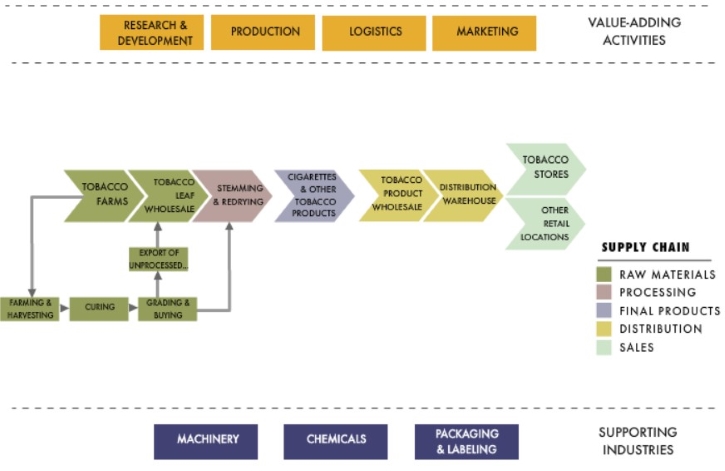Value Chain
The Tobacco Value Chain

Value Chain Description
The tobacco GVC is geographically far-reaching, with producers, processors, manufactures, distributors and consumers spread widely across the world. Within this complex network of global actors, North Carolina in its long history of tobacco production, continues to occupy a highly competitive position within the global tobacco industry. More than leading the nation in tobacco leaf production, cigarette manufacturing, tobacco products exports and overall employment compared to all other states in the U.S., North Carolina participates in virtually each of the key segments of the tobacco value chain. This uniquely situates the state as a microcosm of sorts. Wherein with only minimal imports (based more on product differentiation than necessity to produce), essentially all sequential activities can be conducted within the state: from agricultural inputs and leaf production, to leaf processing, on to manufacturing, and finally on to marketing and distribution. Beyond its well established infrastructure, North Carolina is home to the headquarters of some of the world’s largest tobacco companies. This further serves to uniquely center North Carolina at the heart of the continued global policy debate on tobacco related health concerns. Given all of these factors, North Carolina captures significantly high value from its strategic participation in the tobacco value chain - even in a declining U.S. cigarette market.
Introduction to NCGE Value Chains
Value Chains on the North Carolina in the Global Economy (NCGE)
What is a value chain?
A value chain describes the full range of activities that firms and workers carry out to bring a product or service from its conception to its end use and beyond. This includes activities such as design, production, marketing, distribution and support to the final consumer. The activities that comprise a value chain can be contained within a single firm or divided among different firms and can be contained within a single geographical location or spread over wider areas. For additional background on the origins and research associated with this concept, see the Duke-hosted website, www.globalvaluechains.org.
Value Chain Dimensions
Each industry value chain is composed of three dimensions that work together to produce final products and services for the market. These include:
Value-Added Activities: Value is created in products and services via a series of six steps: research & development, design, production, logistics, marketing and services. Each of these varies in importance based on the industry. In the visual depictions, the top line is composed of the most important value-adding activities for each industry. When you hover the cursor over any “value-adding activities” box information on the activity and its connection to the supply chain appear.
Supply Chain: Each industry has an input-output process that begins with raw materials and continues through the making of components and final products, and finally to distribution and sales. In the value chain visuals, the supply chain is broken into five colors; each representing of the basic stages. When you place your cursor over these boxes, a description of each activity appears along with statistics (based on NAICS codes) on the number of firms, employees and average annual wages per employee in North Carolina (see the Website Overview for information on NAICS codes). The arrows represent the main stages and the boxes listed below represent specific types of products, processes or markets.
Supporting Industries: The supporting environment includes the entities that support and influence actors in the supply chain such as trade and professional associations, government agencies, testing and training facilities, community colleges and universities as well as material and machinery providers. The entities present in North Carolina are located along the bottom row of the visual. When you hover the mouse over these boxes the supply chain stages impacted by the supporting industry is highlighted and statistics or descriptive text is displayed when available.
